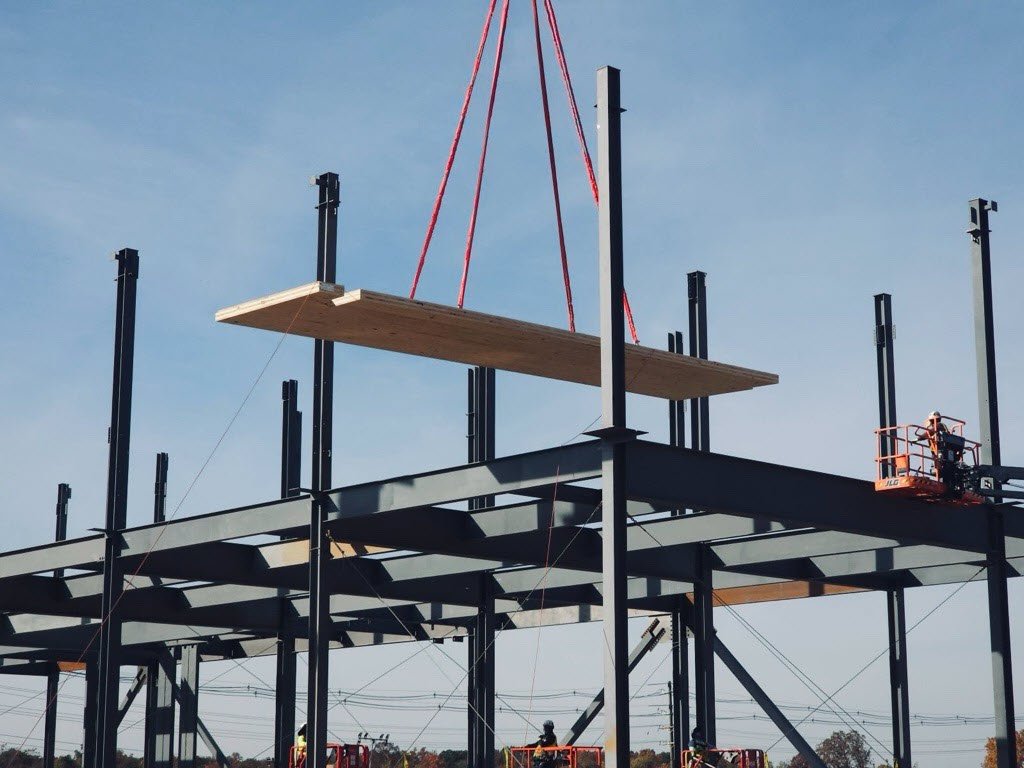- The first wooden data centres by Microsoft aim to reduce carbon emissions by up to 65%.
- The company is overhauling supplier contracts to require carbon-free electricity use by 2030.
In northern Virginia, Microsoft is undertaking an unconventional experiment: building data centres with wood. The company uses cross-laminated timber (CLT), a specialised engineered wood product, in a hybrid construction approach alongside steel and concrete.
The method is projected to reduce the facilities’ carbon footprint by 35% compared to standard steel construction and 65% to typical precast concrete structures. The initiative marks a step in Microsoft’s journey to become carbon-negative by 2030.
CLT, typically made from spruce, pine, or Douglas fir, offers unique advantages over traditional materials. It’s created by glueing together three to nine layers of timber stacked in alternate directions and pressing them into solid panels.
Unlike steel, which can deform under high temperatures, CLT develops a protective char layer that maintains structural integrity longer. The sustainably harvested CLT will replace substantial portions of the thick concrete traditionally used for flooring and ceilings.
Microsoft rewriting the rules of data centre construction
Microsoft is fundamentally transforming its construction practices in the new requirements. The company is implementing strict low-carbon specifications for materials and equipment in data centre construction. With this shift, Microsoft will require selected high-volume suppliers to use 100% carbon-free electricity by 2030, creating a a positive impact in its supply chain.
Jim Hanna, who leads sustainability for Microsoft’s data centre engineering team, acknowledges the complexity: “We have to be system thinkers across the entire value chain of these materials that go into our data centres and the equipment that supplies [them]. That’s what makes it hard but certainly not impossible.”
Investing in tomorrow’s building materials
Microsoft is backing companies developing sustainable construction technologies through its $1 billion Climate Innovation Fund, which has already committed $761 million. The fund targets innovations that can achieve mainstream adoption by 2030, including:
- Stegra’s green steel plant in Sweden, designed to reduce carbon emissions by up to 95%,
- Boston Metal’s oxygen-generating steel production process,
- Electric Hydrogen’s renewable electricity-powered hydrogen production,
- CarbonCure’s carbon-capturing concrete,
- Prometheus Materials’ microalgae-based zero-carbon cement.
The challenge is substantial—according to the World Economic Forum, steel manufacturing contributes approximately 7% of global carbon emissions, while cement production accounts for about 8%.
Brandon Middaugh, manager of the Climate Innovation Fund program, emphasises Microsoft’s unique approach: “What’s not so common [sic] is to see an investor like Microsoft come to the table and say I want to both provide you with capital and also sign a contract to buy the output.”
The company’s scale positions it as a catalyst for market transformation. “Microsoft is in a unique position just because they’re so large,” Thomas Hooker from Thornton Tomasetti, the structural engineering firm working on Microsoft’s Virginia data centres, said. “They can almost be […] a market mover and to some extent push some of these technologies to more widespread use.”
While Microsoft has achieved a 6.3% reduction in direct emissions over three years due to data centre growth, indirect emissions have increased by 30.9%. This challenge underscores the importance of innovative construction methods and materials.
Richard Hage, Microsoft’s global strategy lead for data centre engineering, points to industry-wide momentum: “A lot of our suppliers are on the same journey as we are… implementing key initiatives to lower the embodied carbon of their materials and their products.”
While innovative, the shift to wooden data centres represents just one step in addressing the complex challenge of data centre sustainability. While Microsoft’s supply chain reforms and material investments show promise, the company’s 30.9% increase in indirect emissions highlights the tension between digital infrastructure growth and environmental goals.
The success of these initiatives will ultimately depend not just on the technical viability of new materials but on Microsoft’s ability to scale these solutions across its rapidly expanding data centre network. As the tech industry grapples with its environmental impact, Microsoft’s experiment with wooden data centres could provide valuable insights into sustainable infrastructure development’s practical challenges and opportunities.








